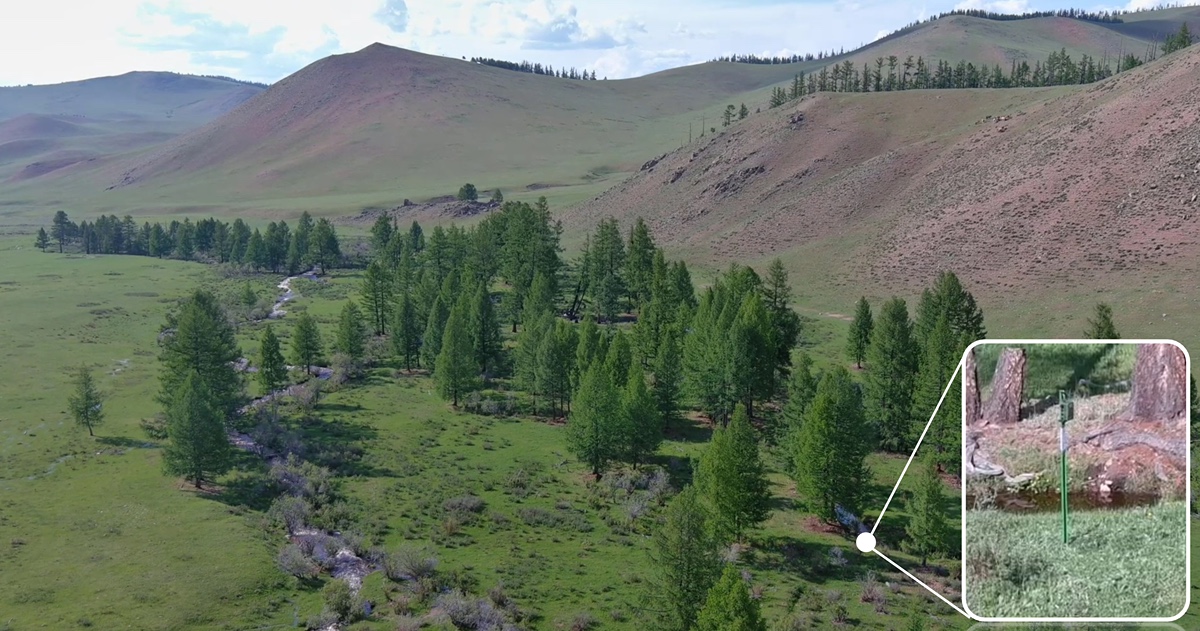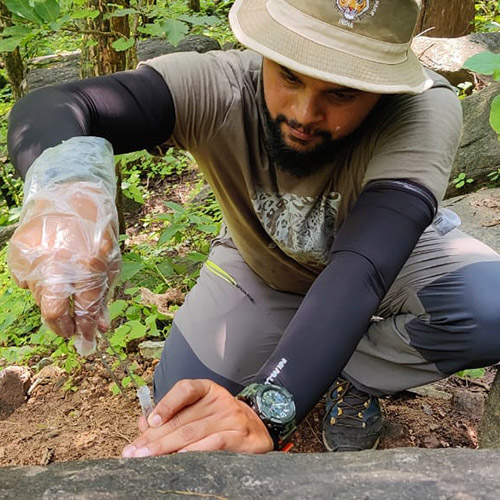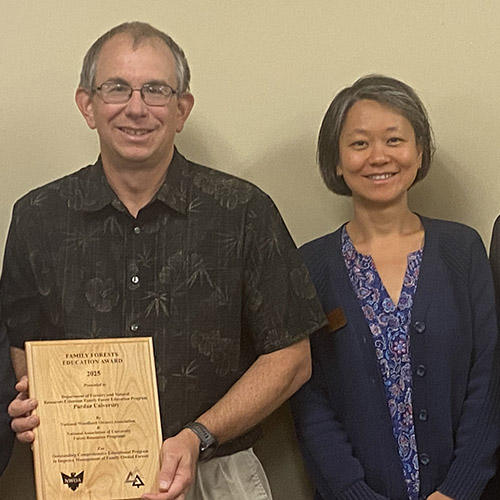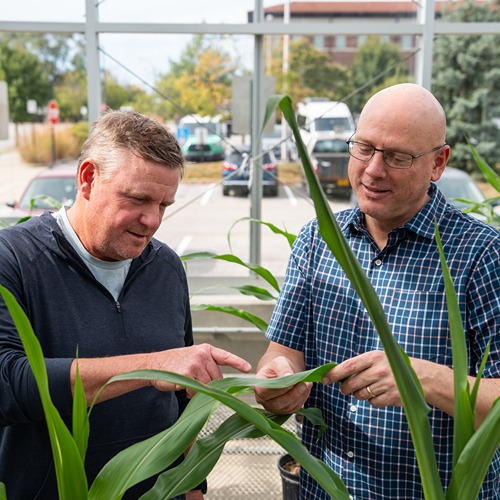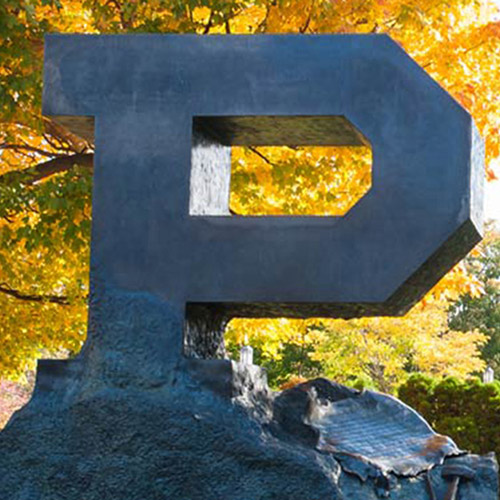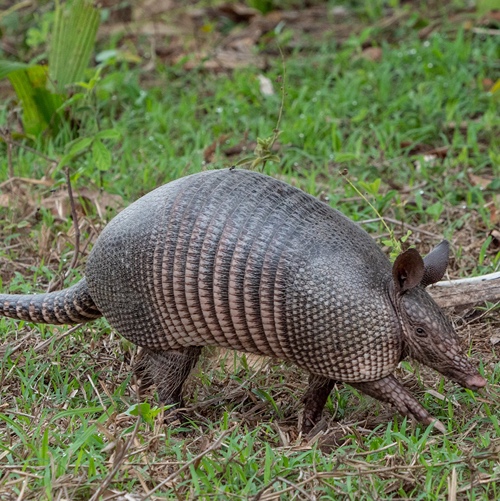FNR Alumni Assist During Wildfire Season
Wildfire season can extend from five to more than seven months in length, occurring mostly in the summer and fall in the Western United States, according to the U.S. Department of Agriculture.
Each year hundreds of individuals from across the nation assist with fighting wildfires, including many from the Purdue Forestry and Natural Resources alumni ranks.
We reached out to our FNR alumni to get their first-hand accounts of this year’s wildfire season and find out how their time in FNR prepared them for their roles in protecting the people and natural resources of the United States. Get to know them a few of them as well as other FNR alumni who have historically been involved with wildland firefighting below.
Susanne Adams (BS Wildlife 1991)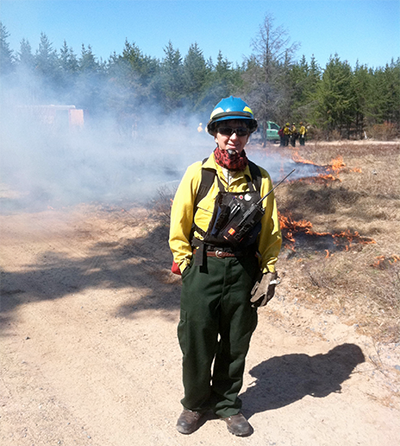
Current Position: Regional Developed Recreation Program Manager for USDA Forest Service
Work History: Susanne was a wildlife biologist for over 20 years. Her current fire position is as a member of an Incident Management Team working in facilities and food. In the past, she has been a member of hand crews, a prescribed burn boss, incident commander (small fires), dozer boss and engine boss.
Susanne has worked fires in four states in 2024 -- two in Idaho and one each in Washington, Wyoming and Oklahoma.
What have you taken away from your experiences in wildland firefighting?
Resilience, focus on teamwork and mission, creative problem solving - and long lasting friendships!
What advice would you give to current and future FNR students considering going into wildland firefighting?
Be comfortable in uncomfortable situations (physically , mentally, emotionally). Flexibility and being able to think clearly in both stressful and low activity times.
How did your time in FNR/degree prepare you for your current position and/or for working in the wildland firefighting world?
Teamwork on assignments and problem solving
Phillip Sneed (BS 1995; Forestry major)
Current Position: Senior Forester/President of Blackwell Creek Forestry (Chillicothe, Missouri)
Work History: Phil began wildfire work in 1996 while working with the Missouri Department of Conservation’s Forestry Division in the Ozarks. His first western fire assignment was on a hand crew in 2000. Since then, he has served as a firefighter, crew boss, engine boss and public information officer, usually spending a couple of months every summer working on out of state assignments. Although he is currently a consulting forester in Missouri, he concentrates his summers on working western wildfires through the state of Kansas. He completed two 14-day assignments this past summer.
Mike Fleischhauer (BS Forestry, 2006)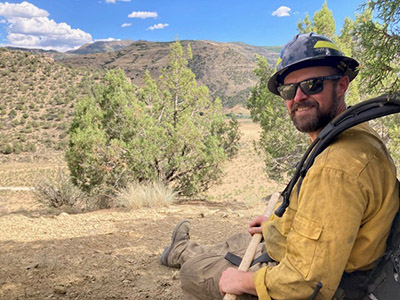
Current position: Forester, Missouri Department of Conservation
Missouri Qualifications- Incident Commander and Chainsaw Training Cadre Member
Federal Qualifications- B Sawyer, Firefighter Type 1, Incident Commander Type 5, Crew Boss Trainee.
Work Experience: My fire time started when I got my forester position in the Ozark Region in 2010. Since that time I have been engaged in fire suppression and all aspects of prescribed burning in south-central Missouri on an annual basis mostly serving as an incident commander and sawyer, although in Missouri on a state fire you tend to do it all: from leading a dozer, to lighting backfire and holding line, to scouting fire and developing strategy, to communicating and coordinating with volunteer fire departments and other agencies, to serving in public relations roles with landowners and affected parties. My federal fire fighting started in 2010 as well, going on Missouri-Iowa Interagency Type 2 Initial Attack 20-person hand crews. Since that time, I have gone on one tour per year most years, and at this time I have probably been out about 12 times. A tour for most our crews tends to be about 18 days, 14 days on the fire line working is the requirement for most fire resources, although you can get cut short or extended, and then a couple days of travel before and after, but depending on travel arrangements has gone up to 4 days before we ever got to our incident. In that time, I served a couple years as a Type 2 fire fighter just doing general labor, then a bunch of years as a B Faller (Type 2 is the newer designation), and most recently I have spent a few years as a squad boss/ICT5 and started work on a crew boss task book. I have gotten a good tour of the country on these trips: Virginia, Boundary Water WCA in Minnesota, Idaho, Montana, Colorado, Wyoming, California and Alaska north of the Arctic Circle.
How did your time in FNR/degree prepare you for your current position and/or for working in the wildland firefighting world?
When I was at Purdue I didn’t take advantage of any of the fire curriculum or opportunities that were available, it just wasn’t on my radar as anything I planned on doing. However, I did get a good well rounded education in silviculture, tree physiology, forest mensuration, and forest products from professors with real world tie ins and experience, as well as some great hands on opportunities working for Don Carlson on Purdue forests throughout Indiana and doing forest inventory on the Hoosier National Forest one summer. And as much as it pains me to say, some of the written and verbal communications classes have come in quite handy throughout my career. I will not speak for others, but I know when I was in school, I dreamed of working in the woods and largely avoiding the unpleasantness that is public speaking, customer relations, etc. Now I realize that is not reality, being an effective and efficient communicator is essential and will serve you well in your career and day to day interactions. All of this education and experience made getting a job that allowed me to participate in the national fire program possible, while maintaining a steady job with good benefits and a fixed location. My agency has also invested significant time and money into my training, certification and gear and supports me in going all over the country to bring home fire and emergency management and leadership experience.
What advice would you give current and future FNR students considering going into wildland firefighting?
Start when you are young, and embrace the experience when you are able to be flexible in your personal life. “Adult Living”, increasing job responsibilities and especially kids will all make working in the fire environment significantly more complex at best and can hinder your ability to perform in a complex and potentially dangerous work environment at worst. Embrace the suck. There will be lots of down time mixed with periods of extreme exertion. Personal hygiene, 8 hours of sleep and a good meal are often not on the agenda or are mixed into a brief period of time after a 16-hour day on the fire line to mix and match in whatever way you find survivable. When you are with 20 people for nearly 2/3 of a month you will find out what and who gets under your skin, especially when you all smell bad and are stuffed into trucks for days on end. Do what you can to stay as comfortable and physically and mentally fit as possible. Don’t sweat the small stuff or you will miss the fact that you are seeing county and having experiences that the average person will never have. You will make contacts throughout the nation and sometimes internationally and get to know close friends that you will bond with in ways that most other people will never understand. If you can keep the discomfort from disengaging your critical thought you may find some tips or tactics to bring home and gain a better understanding of the natural world on a continental scale. Invest in yourself. Stay physically and mentally fit in the off season, the fire environment is no playground and when you are on a mountain side in Idaho 8 hours from the nearest significant civilization is not the time to discover that you are going to have a very tough time hacking it, there is no place to “ring the bell” and quit. Get as much training and knowledge as you can, knowledge is power and training, especially in high stress situations, will bring you comfort and purpose. Nobody wants to see their firefighting professional turn into a panicking tourist because they don’t understand what they are seeing and what they are doing. Spend money on gear that increases your comfort. Money is definitely a motive for fighting fire and you don’t want spend more than you make, but reinvest some of that in high quality socks and underwear, light and comfortable tents and sleeping gear, and above all good boots. When you are not chaffing when you walk, you are getting a sound sleep and not spending all your time setting up your camp each night, and you are in boots that support your feet and you are confident will not fall apart before the tour is over you will have an eminently more enjoyable experience.
Carl Schmidt (BSF 1991; Wildlife major)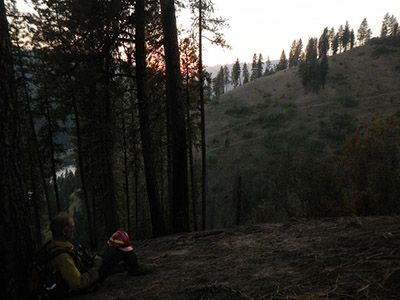
Current Position: Forester at Piedmont National Wildlife Refuge in Georgia
Work History/Fires Served On: Carl has been doing fire work since 1994. Like many people this year, he ended up in Oregon.
“I graduated in 1991 with a BSF, in both Wildlife Management and Forest Management. My first fire season was 1994, with the National Park Service. I ended up doing five seasons with NPS, two with US Fish and Wildlife Service – on engine crews – and one as a hotshot with the USDA Forest Service. I also had two years as a career seasonal with USFWS. Currently I’m the head forester at Piedmont National Wildlife Refuge, in Georgia.
The earlier stages of my fire career focused on wildfire suppression, especially NPS and USDA FS (USFWS was more prescribed fire oriented). I went on numerous engine, hand crew, and helitack details. The fire portion of my career has shifted. My primary emphasis is now prescribed fire. I am a forester on a wildlife refuge that is 99% forested, meaning I use silvicultural tools to accomplish habitat objectives. One of those tools is prescribed fire. I am a Type 2 Burn Boss (RXB2) and a Georgia Certified Burner. I help plan, implement, and evaluate burns conducted for specific habitat objectives, as well as fuel objectives.
My other involvement with fire is Burned Area Emergency Response. I am on the Department of Interior’s National BAER team, as a forester. The purpose of BAER is to prescribe emergency treatments to minimize threats to life or property, and to prevent unacceptable degradation to natural and cultural resources resulting from a fire. My job is to assess hazardous trees, and to evaluate fire-damaged stands for reforestation needs.
How did your time in FNR/degree prepare you for your current position and/or for working in the wildland firefighting world?
Purdue gave me the mensurational and silvicultural underpinning to go to ecosystems outside the Central Hardwoods and still figure out how to accomplish the objectives. What that tells me is, from an educational point of view, the more silviculture and mensuration training one gets, the better positioned they’ll be to both get a job and advance a career – not a career in fire suppression, but one that uses fire as a tool to accomplish management objectives.”
Mitch Hess (BS 2006; Wildlife)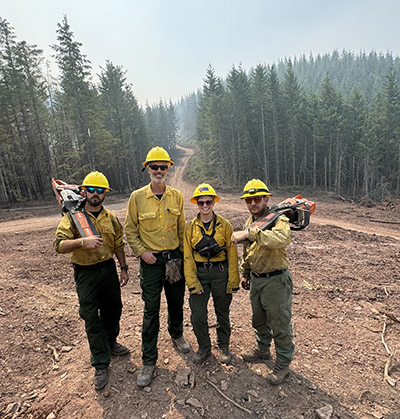
Current Position: Wildlife Biologist/W76D Project Manager for the Illinois DNR Division of Wildlife
Work History: Mitch works wildfires once or twice a summer with the Illinois DNR Type 2 IA fire hand crew.
What have you taken away from your experiences in wildland firefighting?
The experience is different for every roll. You never know what incident command (IC) needs from you before you go. I have gotten to see parts of the country I would have never known to go to. The feeling of helping others and making a difference keeps me going back out.
What advice would you give current and future FNR students considering going into wildland firefighting?
It can be extremely hard work and tiring at points and other times slow. Be adaptable and flexible at all times.
How did your time in FNR/degree prepare you for your current position and/or for working in the wildland firefighting world?
I worked at Martell Forest during my undergrad. I assisted with a lot of prescribed fires while there which ignited my interested in Wildland Fire.
 Blake Stanton (BSF 2003; Forestry major)
Blake Stanton (BSF 2003; Forestry major)
Current Position: Forester with the Department of Defense
Fire Quals: ICT4, RXB2, FIRB, ENGB, DOZB
Work History/Fires Served On: Blake moved to Washington state in 2008 and got a job with the DoD at joint base Lewis McChord, which was called Fort Lewis at the time.
Aaron Holsapple (BSF 1994)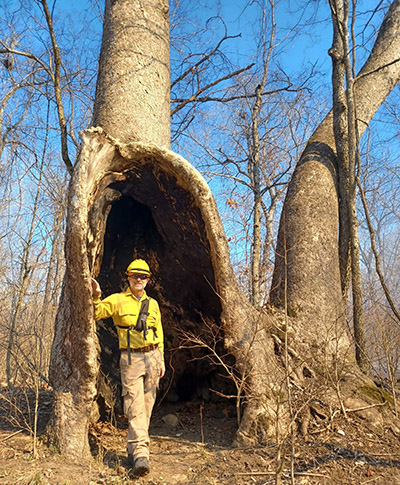
Current position: Forester, Missouri Department of Conservation
Work History/Fires Served On: Aaron’s last trip for fire work was three summers ago, but he has been out on six western fire trips including his first excursion to Idaho in 2006. Currently he is qualified as an ICT5 Squad Boss traveling with the Missouri-Iowa consortium. Within Missouri, Aaron conducts prescribed burns on woodland, glade and warm season grass cover types primarily to suppress woody vegetation. Explain the experience for those who have never been on a wildland fire scene.
What have you taken away from your experiences in wildland firefighting?
The intensely difficult terrain of western U.S. mountains really opens the eyes, and lungs, of us Midwesterners! Each time I go on a trip it reminds me of the importance of physical conditioning. Incident Command infrastructure and the organizational aspects of the base camp are impressive to witness firsthand. Logistics, communications, medical services, food services and even sanitation services are a few support systems integral to the success of the camp’s mission.
What advice would you give current and future FNR students considering going into wildland firefighting?
Western fire crews are the epitome of self-sufficiency, flexibility, and adaptability when it comes to their ever-changing work environment. Each day can present different assignments you and your teammates must undertake all the while dealing with changing weather and topography. It’s a great opportunity to stretch your mental and physical capabilities while protecting public and private property.
How did your time in FNR/degree prepare you for your current position and/or for working in the wildland firefighting world?
Understanding the role of wildfires and its influence on our landscape in the historic record revealed how preeminent fire is to our current cover types. Dendrochronology and the occurrence of fire scars was an extremely fascinating topic in Dr. Andy Gillespie’s Advanced silviculture class.Jenny Lesko (MS 2017)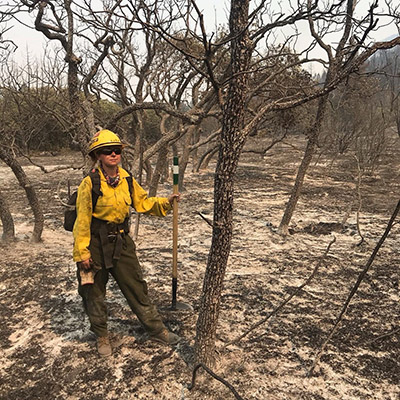
Current Position: District Forester for the Illinois Department of Natural Resources
Work History: While Jenny is not working any fires this year, she usually does an assignment or two each year with the Illinois DNR Type 2 IA fire hand crew. The Illinois DNR deploys a crew or two every summer to help with whatever wildfire locations need help.
What have you taken away from your experiences in wildland firefighting?
On scene there is a good chance of seeing burned up trees and active fire behavior. Expectations on a hand crew often include cutting down trees along roads, moving brush, using hand tools to make fire line, guarding the edge of the fire, putting out smoking areas after the fire has gone through, camping, eating at fire camp, morning briefing, etc. I have taken away the idea of doing what needs to be done and working hard to achieve set goals.
What advice would you give current and future FNR students considering going into wildland firefighting?
I highly recommend it, even if like me you’re just doing this for a few weeks in the summer. Be in shape, work hard, don’t complain. Wildland firefighting can give you a lot, including leadership, lifelong friendships, and the ability to push yourself. Also, getting this chance to travel to incredible places has a way of changing your way of thinking (in a good way).
How did your time in FNR/degree prepare you for your current position and/or for working in the wildland firefighting world?
At Purdue I took the introductory fire classes, S-130 and S-190, which are required nationwide for anyone that is going to be involved in wildland firefighting. Additionally, tree ID, silviculture, disturbance ecology, and forest management classes were important to my understanding of wildfire and its impacts on forests.
Judge Larry Medlock (BSF 1980; Wildlife emphasis)
Work History/Fires Served On: Larry had completed his second year as a student at Purdue when he applied for a seasonal position with the U.S. Forest Service. He was selected and assigned to the Modoc National Forest in Northern California. As a young seasonal employee, he was provided with a week’s worth of fire training and became a Region 5 (California) Wildland Firefighter. He and his colleagues were “given paper sleeping bags and told to watch out for rattlesnakes.”
Judge Medlock said: "There are a lot of fires in California in the summer and I had the opportunity to experience wildland fires in person in California, Nevada and Oregon. I think I may have gone to Arizona on an assignment as well. It was an adventure for a country boy from the corn fields of Indiana. One of the fires I was involved it was called the Scarface Fire, which was 80K+ acres of torched material. To see a wildland fire of such magnitude is an amazing sight and experience. I will never forget my days as a R-5 Wildland firefighter. When they were asking for volunteers 10-15 years ago, I submitted my name for consideration. Once you experience it, it becomes a part of you. It’s hot, dirty, dangerous work. Times have changed but the business of wildland fire suppression in remote areas is still basically the same.”
Current Students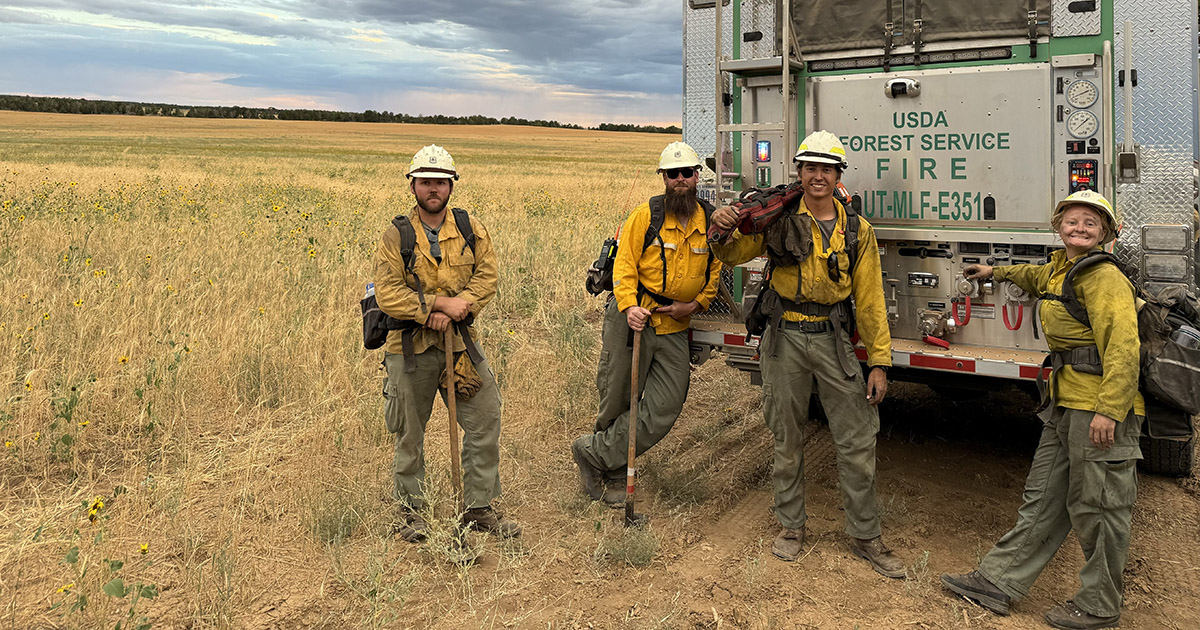
Undergraduate student Zane Smoldt served as a forestry technician and wildlife firefighter on a type 3 engine crew for the south zone of the Manti-La Sal National Forest. In this role as a wildland firefighter on a type 3 engine crew for the south zone of the Manti-La Sal National Forest, Zane was responsible for initial attack on wildfires, extended attack (when ordered) and patrolling the forest, as well as completing fuel reduction thinnings and project work on prescribed burn units in the forest.
